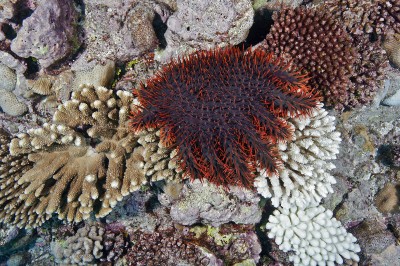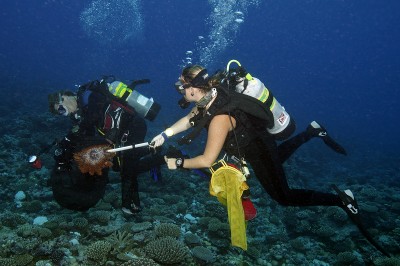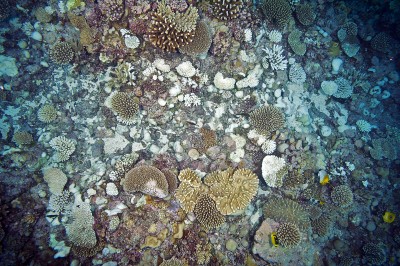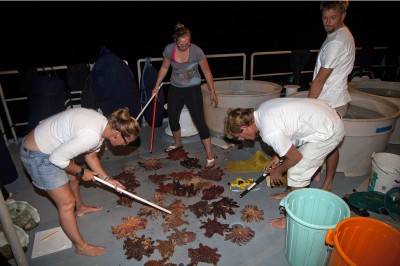COTS: Aitutaki
By James Barrat

In May 2013, when the science team of the Khaled Bin Sultan Living Oceans Foundation plunged into the waters surrounding Aitutaki in the Cook Islands, we discovered a reef in crises. Something had damaged between 80 and 99 percent of the island’s coral reef systems, but what? The telltale white skeletons of recently eaten branch coral pointed to the culprit – Acanthaster planci, or Crown of Thorns Starfish, named for its helmet of venomous spines. For reefs in the Pacific and Indian Oceans, only cyclones and bleaching events cause more destruction than the voracious Crown of Thorns.
Coral Killers

Where other starfish have five arms, the Crown of Thorns Starfish, or COTS for short, have between fourteen and twenty one. They move fast for starfish – 20 meters an hour. Each night the nocturnal COTS can eat its own body area in coral, and they can grow up to a meter in diameter. That means on average one COTS can consume 13 square meters of reef per year. During population spikes, clusters of COTS eat living coral polyps faster than the coral can grow and reproduce. And the COTS menace is growing even worse. Once COTS ate only the fast-growing corals that thrive in shallow water. After a COTS outbreak, these coral can grow back in a few years. Now, Crown of Thorns Starfish also go after deeper, slower-growing corals, like the reef-building species, Porites. Once these corals are damaged, the reef’s recovery can take a century!

Outbreaks of Crown of Thorns Starfish
To fight the outbreak around Aitutaki, science divers from our research team collected 540 COTS from ten different sites, by hand. On the research vessel, M/Y Golden Shadow, Chief Scientist Andy Bruckner led the effort to measure the animals and put them in buckets of fresh water, where they died of suffocation. Bruckner used to deplore such tactics, believing that a “hands off” management style was best for reefs. Now he favours intervention when it redresses problems caused by humans.
“Sewage and agricultural runoff going into the oceans may increase the likelihood of COTS outbreaks,” said Bruckner. “They do that by feeding the plankton that in turn feed COTS larvae. More Crown of Thorns Starfish larvae survive to adulthood, eat more coral, and reproduce. It doesn’t help that COTS are the most fertile invertebrate in the world.”

Over harvesting COTS’ predators is another way humans contribute to outbreaks of Crown of Thorns Starfish. The trumpet triton, helmet snail, as well as wrasse, triggerfish, and puffer fish all help keep COTS populations in check. Fishermen overharvesting these animals leaves fewer of them around to eat any COTS living on the reef.
And once COTS are settled into a reef system, they’re hard to remove. After divers collect COTS on a reef, they usually have to search the reef again to prevent a secondary outbreak. When the Foundation trains local divers to manage COTS, we instruct them to remove the animals from the sea and bury them on land. That’s because breeding adults that are wounded or poisoned and left on the reef are likely to spawn. When local people help capture COTS they see the crises first-hand, and become committed COTS controllers. And that increases any reef’s chances for survival.

With its COTS crises under control, can Aututaki’s reef recover? Andy Bruckner thinks they can. “These reefs supported a variety of coral before the attack, and varied reef systems regenerate fastest. Even when starfish all but wipe out a reef, coral larvae can re-seed damaged areas. With good management, this reef can come back to life.”